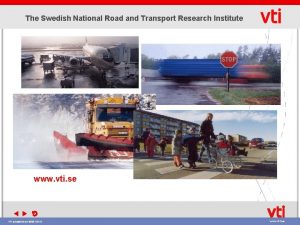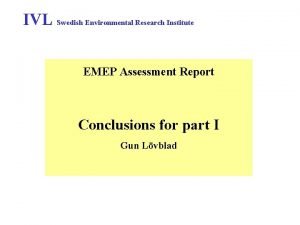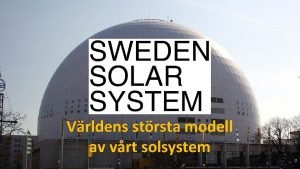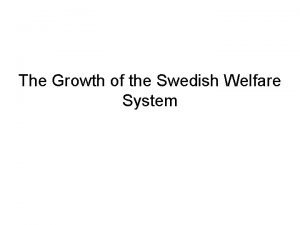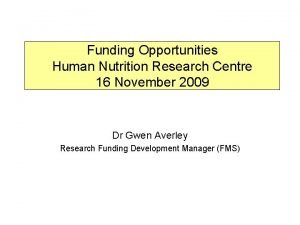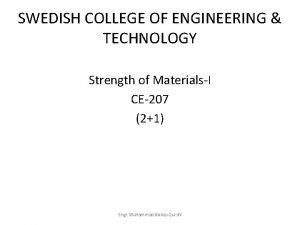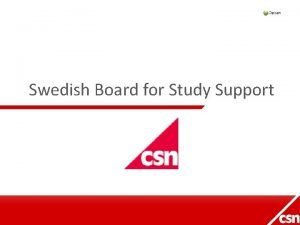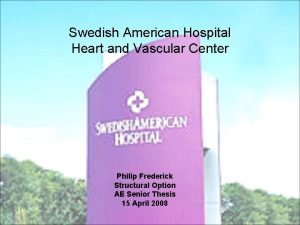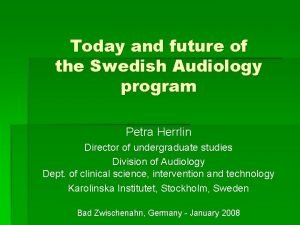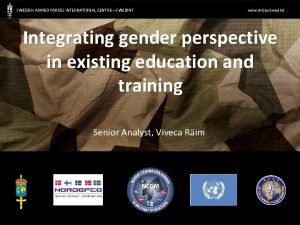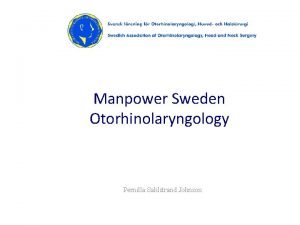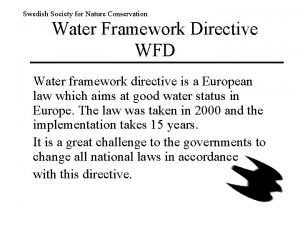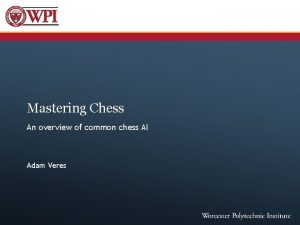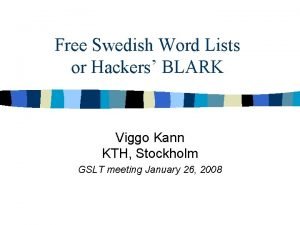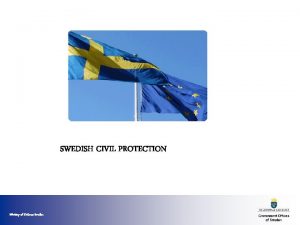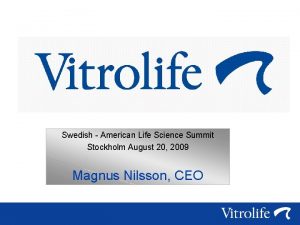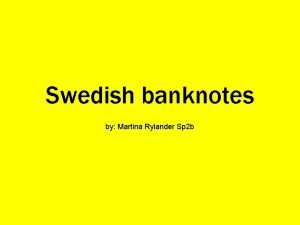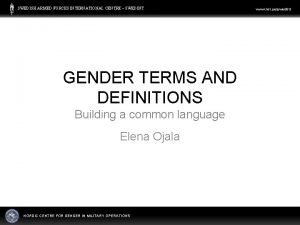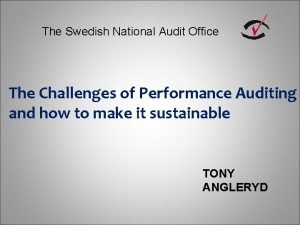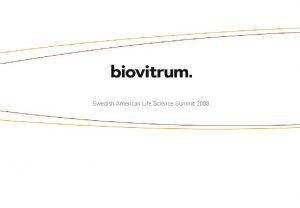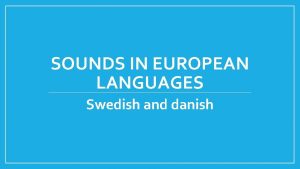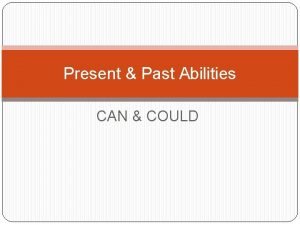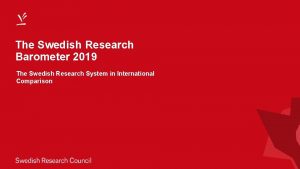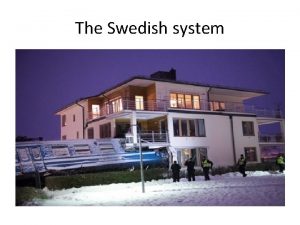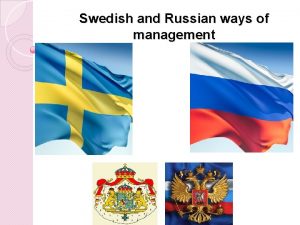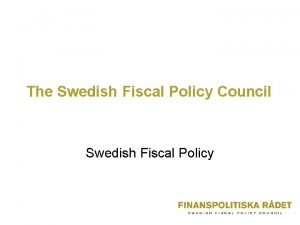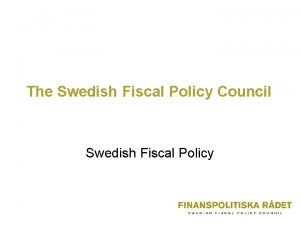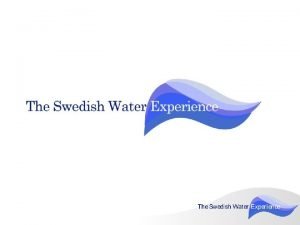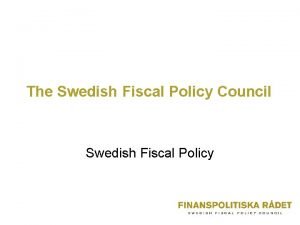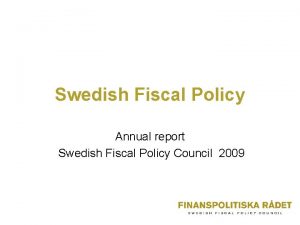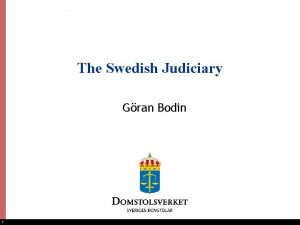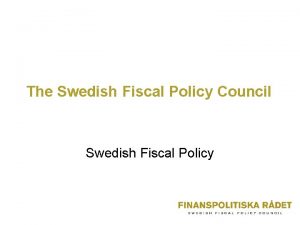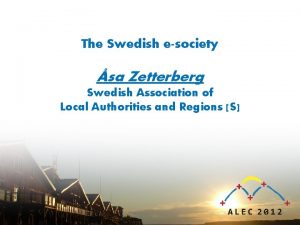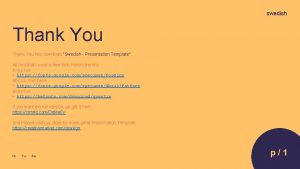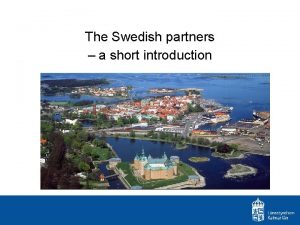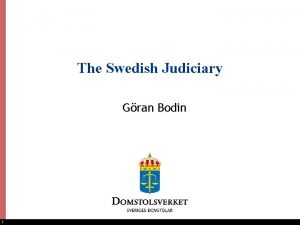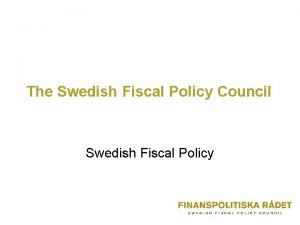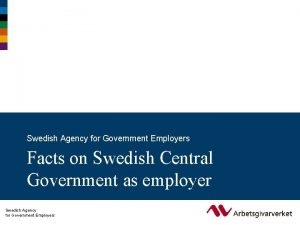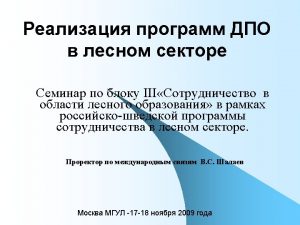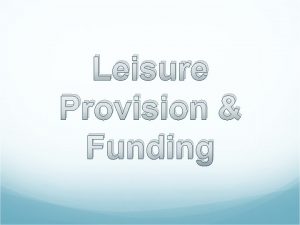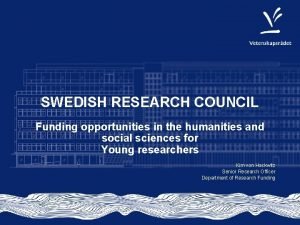Swedish research funding system and roadmap for research





























- Slides: 29

Swedish research funding system and roadmap for research infrastructure High energy physics and accelerators Lars Börjesson Secretary General, Research Infrastructure

N 78° 04. 30 May 9

Agencies for research funding • Vetenskapsrådet - Swedish Research Council • FORMAS – Swedish Research Council for Environment, Agriculture Sciences and Spatial Planning • FAS – Swedish Council for Working Life and Social Research • VINNOVA – Swedish Agency for Innovation Systems

Swedish Research Council - Missions Research Information Research policy Research funding

Organisation

Funding of high energy physics and accelerators • Science Council for Natural Science and Engineering – Project grants – Research positions • Committee for Research Infrastructures – – Memberships in international organisations Equipment grants Planning grants for infrastructures Operations • New process for LHC related grants - 1. Scientific quality. 2. LHC relevance

Aim of the Committee for Research Infrastructure The committee shall work for and support the construction and utilisation of research infrastructure (RI) for Swedish research of the highest quality in all scientific disciplines. Tasks • review of proposals – – • • • planning grants for RI expensive equipment grants for databases grants for operation of RI assessments of existing and planned RI represent Sweden in international collaborations long term strategic work, e. g. a roadmap for RI

Funding structure of the Committee Total annual budget ~ 700 MSEK (≈ 75 M€) • Memberships in international facilities (40 %) – CERN, ESO, ESRF, EMBL, EUI, IARC, Ice. Cube, ILL, CESSDA etc • • Expensive research equipment (15 %) Operations of RI (18 %) Planning grants for new or updated RI (10 %) Grants for building up databases for medicin, social scinces, climate and environmental research. (7 %)

Members of the Committee for Research Infrastructure 9 members from scientific community, presently with expertise in: astronomy, hadron physics, scientific imaging, zoo-physiology, linguistics, materials science, bio-informatics, medical biotechnology 4 members represent other governmental research agencies; VINNOVA (agency for innovation systems), FORMAS (Research council for environment, agricultural science and spatial planning), FAS (Council for working life and social science), FOI (defense research agency).

KFI: s review groups • Infrastructures for astronomy and particle physics High energy and nuclear physics, fusion, astronomy • Infrastructures for molecular, cell och materials research Synchrotron and neutron facilities, micro/nano fabrications labs, biobanks, ”genome core facilities”… • Infrastructure for research on earth och it’s close surronding Climate, environmental, polar, atmosphere, geological research… • Infrastructure for e-Science Research data bases, high performance networks and computing…

Funding of HEP and accelerators by Research Infrastructure Committee Membership • CERN, Ice. Cube Equipment grants • ATLAS, ALICE, CLIC, Ice. Cube, AGATA, LCG Nordic Tier 1 Planning grants for infrastructures • XFEL and FAIR In-kind contributions to new accelerator facilities • XFEL and FAIR –Detailed design studies • MAX IV and ESS

Swedish Strategies for Infrastructures Second issue of a Swedish roadmap for research infrastructure recently (2008) published for all fields of science. The roadmap has a perspective of 5 - 20 years and will regularly be updated Reviews of infrastructure needs and projects • Astronomy, particle and nuclear physics • e-Science • Energy • Planet earth • Humanities and social sciences • Medical and life sciences • Materials science

General conclusions • Increase national coordination of RI for efficient utilisation of resources and skills. • Increase involvement in international RI • Invest in national nodes to international RI • A balance between funding of research and investment in and operations of infrastructures • Open access principle of research infrastructures and the data obtained there • Priority systems - research of the highest quality should be the criterium for access to the facilities • Funding should be doubled over a four year period

High priority accelerator projects European spallation source XFEL, Hamburg Decision to be member MAX IV synchrotron-FEL FAIR, Darmstadt Decision to be member

Two world leading research facilties proposed to be built in Lund MAX IV – construction can start 2009 ESS – construction can start after 2011

MAX-IV: Tool for Scientific Discovery • Will be a Swedish/Nordic/Baltic facility • Will be a world leading synchrotron light facility • Will be build 2010 -2012, • Investment cost 2. 5 B SEK (260 M €) • With energy/climate strategy to make it CO 2 neutral

Evaluation of the scientific case and the design concept November 2006 Expert members of the evaluation panel • Prof. Yvan Bruynseraede, K. U. Leuven, Belgium • Prof. Maria Arménia Carrondo, Universidade Nova de Lisboa, • Portugal Prof. Wolfgang Eberhardt, BESSY, Berlin, Germany • Prof. Michael Grunze, Heidelberg, Germany Prof. Britt Hedman, SSRL, Stanford, USA • Prof. Chi-Chang Kao, NSLS, Brookhaven, USA ”The Evaluation Panel is unanimous in its conclusion that the scientific case for a MAX IV facility is very strong, representing a site for intrascientific challenges as well as interscientific advances and an important resource for upgraded industrial research in the Nordic and possibly Baltic countries. The Evaluation Panel is clear in its recommendation to the Swedish Research Council: MAX IV should be funded to the level requested, and the funding should commence as soon as possible.

The commission by the Swedish government • The Swedish Research Council have the commission to further investigate the technical and financial issues related to the MAX IV project, including interest from other national and international potential stakeholders. • The report is due by June 1. • High interest among Universities, Foundations, all Nordic and Baltic countries and Poland

European Spallation Source: Tool for Scientific Discovery • Will be a European/international facility • Will be the world leading neutron scattering facility • Will be built 2010/11 -2018/19 • Investment cost about 14 B SEK (1. 47 B€) • With energy/climate strategy which will make it CO 2 -neutal • Decision to be taken 2008 -2009

ESS Energy Concept: Renewable energy Responsible use of energy Reuse of energy

Negotiations in four steps • • • Feb 07 Decision by Swedish government to offer 30 % of investments and 10 % of operations Febr - okt 2007: Information and exchange of views. Round table 1, Oct 2007 Okt - februari 2008: Technology plan, possible in-kind contributions and update. Mo. U with CERN under preparation, SNS … Round table 2, Feb 2008 -2009: Choice of site, organisation, funding. Round table 3, Sept 2008 ESFRI site evaluation report Sept 2008, site decision Dec 08

Building of partnership • • • Denmark, political decision on co-hosting Norway, Finland, Iceland Mo. U Baltic states Mo. U Poland -Mo. U Germany, France, UK The Netherlands, Belgium Italy Switzerland The Czech Republic

Funding of ESS • • • Sweden offers to pay 30 per cent of investment and 10 per cent of operating costs Sweden is negotiating with Denmark on cohosting/co-siting the ESS Sweden aims to gather 15 per cent from the Nordic -Baltic states, including the Danish contribution Sweden aims to gather 5 per cent from the Nordic business community Sweden expects other European countries to contribute 50 per cent based on GDP-sharing


Our goal for 2008 • • Site evalutation report, 25 April Update of the Reference Design Nordic-Baltic coalition Broader European coalition Involvement of business Consensus about Lund as the preferred site Presentation at the EU Conference in Versailles, December 2008

3 Ge. V undulator 1. 5 Ge. V undulators ALS undulator ESRF undulator MAX II undulator 3 Ge. V wiggler Caculations using SPECTRA

Definition of research infrastructure For example large research facilities databases, biobanks, extensive computing resources and networks. They must: • be of broad national interest • provide scope for outstanding research • be used by several research groups with highly advanced research projects • be so extensive that individual groups are unable too operate them unaided • have a long-term planning scientific, technical and funding plan • provide open and easy access to all researchers, on a best science basis

Tasks of the review groups • Review of grant applications (expensive equipment, planning grants. . ) • Make inventories of existing and planned infrastructure • Review of the current standing of the field and expected needs in 5 -15 years • Make recommendations for action; new or upgraded infrastructure, decommissioning, reorganisation, cooperation, etc

High priority: complete construction of approved infrastructures • The telescope ALMA in Chile (ESO)* • The Database Infra. Structure (DISC) • The neutrino-telescope Ice. Cube at the South Pole station* • The fusion facility ITER* • LHC vid CERN * • MAX-lab, synchrotron facility in Lund • Nordic datagrid facility (NDGF)* * Swedish involvement
 Swedish national road and transport research institute
Swedish national road and transport research institute Ivl swedish environmental institute
Ivl swedish environmental institute Swedish solar system
Swedish solar system Swedish welfare system meme
Swedish welfare system meme Nutrition research funding
Nutrition research funding Friction with english and swedish neighbors
Friction with english and swedish neighbors Swedish college of engineering and technology
Swedish college of engineering and technology Swedish ob gyn first hill
Swedish ob gyn first hill Swedish life sciences
Swedish life sciences Csn sweden
Csn sweden Swedish american heart hospital rockford illinois
Swedish american heart hospital rockford illinois Swedish audiology
Swedish audiology [email protected]
[email protected] Pernilla sahlstrand johnson
Pernilla sahlstrand johnson Swedish society for nature conservation
Swedish society for nature conservation Swedish chess computer association
Swedish chess computer association Random swedish words
Random swedish words Swedish verbs conjugation
Swedish verbs conjugation Swedish e-identification
Swedish e-identification Swedish civil defence
Swedish civil defence Swedish american life science summit
Swedish american life science summit Swedish employment service
Swedish employment service Swedish lemon angels
Swedish lemon angels Swedish banknotes
Swedish banknotes Swedish armed forces international centre
Swedish armed forces international centre Swedish national audit office
Swedish national audit office Swedish american life science summit
Swedish american life science summit Swedish alphabet sounds
Swedish alphabet sounds Funda denizhan
Funda denizhan Present perfect climb
Present perfect climb
